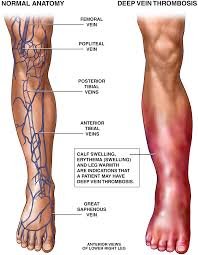Introduction
Deep Vein Thrombosis (DVT) is a serious condition where a blood clot forms in a deep vein, typically in the legs. If left untreated, it can lead to life-threatening complications like pulmonary embolism. Recognizing DVT symptoms early is crucial for timely treatment and prevention of severe health issues.
What is Deep Vein Thrombosis (DVT)?
DVT occurs when a blood clot forms in one of the deep veins, obstructing normal blood flow. It most commonly affects the legs but can also develop in other areas of the body. The primary concern with DVT is the possibility of the clot breaking loose and traveling to the lungs, causing a pulmonary embolism.
Common DVT Symptoms
Many people with DVT may not experience obvious symptoms, making it a silent but dangerous condition. However, some common warning signs include:
1. Swelling in the Affected Leg
- One of the most noticeable signs of DVT is sudden swelling in one leg.
- The swelling may worsen over time and feel warm to the touch.
2. Pain or Tenderness in the Leg
- Persistent pain or cramping in the calf or thigh can be an early symptom.
- The discomfort may worsen when standing or walking.
3. Red or Discolored Skin
- The affected area may appear red or develop a bluish tint.
- The skin might also feel warm and irritated.
4. Veins That Appear Larger Than Usual
- Sometimes, surface veins become more prominent and swollen.
- This symptom is often accompanied by tenderness in the leg.
5. Leg Fatigue or Heaviness
- A sensation of heaviness or tiredness in the leg, even after rest.
- Some individuals feel increased pressure in the affected area.
Complications of Untreated DVT
If DVT symptoms are ignored, it can lead to severe complications, including:
Pulmonary Embolism (PE)
A life-threatening condition where the blood clot breaks free and travels to the lungs, blocking blood flow. Symptoms include:
- Sudden shortness of breath
- Chest pain that worsens with breathing
- Coughing up blood
- Rapid heart rate
Post-Thrombotic Syndrome (PTS)
PTS occurs when long-term complications arise due to vein damage from DVT. Symptoms include:
- Persistent swelling
- Chronic leg pain
- Skin ulcers in severe cases
Causes and Risk Factors of DVT
Certain factors increase the likelihood of developing DVT, including:
1. Prolonged Immobility
- Long flights or car rides
- Extended bed rest after surgery
2. Medical Conditions and Genetics
- Blood clotting disorders
- Cancer or chemotherapy treatment
3. Pregnancy and Birth Control Pills
- Increased estrogen levels contribute to clot formation.
- The risk is higher during pregnancy and postpartum.
4. Obesity and Smoking
- Excess weight puts pressure on veins.
- Smoking affects blood circulation and clotting factors.
5. Previous History of DVT
- If you’ve had DVT before, your risk of recurrence is higher.
When to Seek Medical Attention
Seek medical help if you notice any DVT symptoms, especially if you experience:
- Sudden swelling in one leg
- Persistent pain or discomfort
- Red or warm skin
- Signs of pulmonary embolism (shortness of breath, chest pain)
Early diagnosis and treatment can prevent serious complications.
Diagnosis and Treatment Options
How is DVT Diagnosed?
Doctors use several methods to confirm DVT, including:
- Ultrasound: The most common test to detect blood clots.
- D-Dimer Test: A blood test that measures clotting activity.
- Venography: X-ray imaging with contrast dye.
- MRI or CT Scan: Used in some cases to visualize deep veins.
Treatment Options for DVT
Treatment focuses on preventing the clot from growing or breaking loose. Common approaches include:
1. Blood Thinners (Anticoagulants)
- Help prevent new clots from forming.
- Common medications include warfarin, heparin, and direct oral anticoagulants.
2. Thrombolytic Therapy
- Used in severe cases to dissolve the clot quickly.
- Typically administered in a hospital setting.
3. Compression Stockings
- Improve blood circulation and reduce swelling.
- Help prevent post-thrombotic syndrome.
4. Surgical Procedures (Rare Cases)
- Inferior Vena Cava (IVC) Filter: Prevents clots from reaching the lungs.
- Thrombectomy: A procedure to remove a clot directly from the vein.
Preventing DVT
1. Stay Active and Move Regularly
- Avoid sitting for long periods.
- Stretch and walk during long flights or car rides.
2. Wear Compression Stockings
- Beneficial for individuals at high risk of DVT.
- Reduce swelling and improve blood flow.
3. Maintain a Healthy Lifestyle
- Exercise regularly.
- Maintain a healthy weight.
- Avoid smoking.
4. Stay Hydrated
- Drinking enough water helps prevent blood thickening.
5. Follow Medical Advice if At Risk
- If you have a history of DVT or other risk factors, consult your doctor for personalized prevention strategies.
Conclusion
Recognizing DVT symptoms early can save lives. If you experience swelling, leg pain, or skin discoloration, don’t ignore it—seek medical advice immediately. With proper awareness, early detection, and treatment, you can reduce the risks associated with DVT and maintain a healthy circulatory system.






